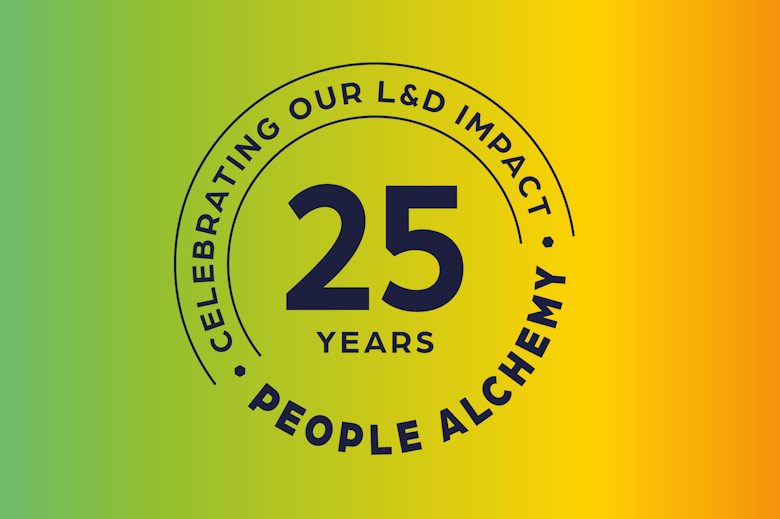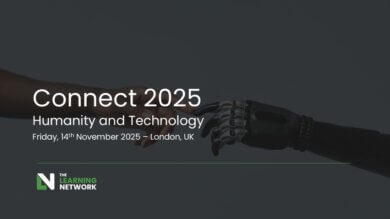
This week is the 25th anniversary of me leaving corporate land, starting People Alchemy and setting out on my own in the world of L&D.
Like many in L&D, I didn’t start out with L&D as a choice. Like many, it just kind of happened through a series of ‘happy’ accidents.
From customer to practitioner
I was a customer of L&D long before I became a practitioner. I attended training courses, and I sent people in my team off on training courses. Back then, there was little else besides a training course, and I didn’t give much thought to whether the course was ‘good’. It was logistically convenient and at the right price, so I bought it. I cringe in hindsight.
One day I was asked to deliver some training on a subject someone figured I knew a bit about, and with much trepidation, I did it. I survived and didn’t ‘fail’ because the happy sheet said people liked the course, or maybe they liked my jokes and felt sorry for me and my fumbling delivery skills. I started working part-time for a training company and rather enjoyed it, being the sage on the stage deftly switching from one OHP acetate to the next.
Despite being told I was good at training because the happy sheets said so, my engineering mind was uncomfortable. What was I really doing? Why was it being done? Did it make a difference? It felt a bit like cranking a handle on a wall where I couldn’t see the other side. But I was paid to crank, so that’s what I did.
The shift to Learning Transfer
Fast-forward many years, and it did take that long, the questions remained, and I started thinking about learning transfer, training course impact, and ongoing performance support, although I wouldn’t have used those words back then.
It bothered me that training courses ‘failed’ in the sense that they didn’t make much difference. Not just the courses I delivered, but most courses. As an engineer, if I designed machinery with that level of failure, I would be out of a job, and maybe even injuring the people who used my designs. Something was wrong in the world of organisational L&D.
The Learning at Work trilogy
I can’t say I set out to fix the world, but I did start thinking about how things could change for the better and how I could make a difference. That led me to the topics for my books. The first, “Informal Learning at Work“, was inspired by the work of Jay Cross and others. Too often, we ignore what is right in front of us in terms of how people learn what they need to know to do their jobs.
Then I turned my attention to the reason so many people appeared on training courses that were unsuitable for solving the stated performance issue. “Capability at Work” was my attempt to pull together the kind of diagnostics process that should be done before any learning initiative is considered. It is a process to help the person requesting training to see what they actually need rather than just what they want.
The third book in the trilogy tackled the biggest elephant in the room. “Learning Transfer at Work” looks at how to ensure that, following a training course, people start doing things differently. I sincerely hope the books have helped people shift their thinking and change their mindset about three of the elephants in the L&D room.
The Concept of Learning Workflows and the Learning Workflow Platform
At heart, I am still an engineer, and engineers like building things. So, I built a software platform to fill what I see as a gap in the range of L&D tools. If you want people to change their behaviour as a result of an L&D programme, it has to include a lot more than just attending a training course or doing some elearning. People need to experiment, practice, reflect, discuss and much more.
I coined the term ‘learning workflow’ to describe the concept of a workflow of activities spread over time that would lead to a new behaviour or set of behaviours. I first proposed the concept in my book on learning transfer. In my opinion, you will get little or no learning transfer without a ‘learning workflow’. And if you want to do that at scale, you need a Learning Workflow Platform or LWP.
Looking to the future
This platform is now the focus of my company, People Alchemy, which is 25 years old this week, and the company birthday is the reason I am reflecting here on some of the things that have happened over that time. L&D has been an amazing sector to work in, and I am grateful for the wonderful people I have met and the experiences I have had along the way.
I am looking forward to more 🙂
Speaking of wonderful people, maybe you and I should have a chat about what challenges you have in your L&D practice. Do get in touch.
My best wishes, Paul



